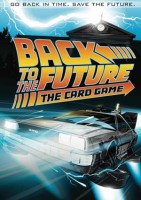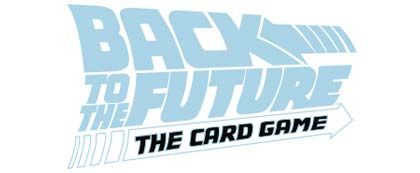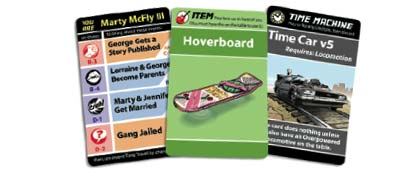
Back to the Future: The Card Game
2-6
11+
20+

Go back in time. Save the future.
Now you can jump into the action of the Back to the Future movies, with this ingenious new time travel card game! Play as the descendants of Marty McFly, Biff Tannen, Doc Brown and others, as you travel back to the events depicted in the movies. Your mission is to make sure pivotal events are not changed by other time travelers before time travel itself gets un-invented. Using a unique, patented game mechanic for simulating time travel, Andrew Looney now puts you in the driver's seat of the famous DeLorean!

The game is played entirely with cards, but has the feel of a board game since important events are represented by a special grid of 24 cards called the TimeLine.
User Reviews (1)
Add a Review for "Back to the Future: The Card Game"
You must be logged in to add a review.

Back to the Future. Anyone who has grown up in the 80’s is familiar (or should be familiar) with the movie franchise, Marty McFly, Doc Brown, and Biff Tannen. And of course, the classic Delorian and the Flux Capacitor. So what happens when you introduce a host of characters bent on using Doc Brown’s time travel technology to change events to ensure their own personal place in history? Chaos. Absolute chaos. And also, Back to the Future: The Card Game.
The premise of this game is that each character has a timeline that conflicts with all the other characters’ timelines. For one to exist, the timeline has to be altered so that all the events in the past match up with a character’s history. One person might need to have Doc Brown Committed, while another person might need to have Doc Brown Commended instead. To change the timeline, players must play cards that allow them to change key events (called linchpins) in time that alter other events with a cascade event. Once all the past events line up with a character’s personal timeline, they must solidify their timeline and win the game by returning to the point in time where Doc Brown invents Time Travel, and prevent that event from happening. This destroys the time machine completely, and in effect, all other characters are erased from existence. Harsh, I know, but that’s time paradox for you.
Back to the Future plays a little bit like Fluxx, but is a separate type of game entirely. To start the game, the timeline is laid out on the board as per instructions: There are four different periods in time, with six different events in each time period. Each player selects a character card to represent themselves in the game, and each character card has a set of events that are required to be resolved before that character can win the game. After selecting a character, each player gets an opening hand of cards. These cards can be anything from key items that can be used to affect other cards or power others, time machines that allow you to go back in time to affect the past (or future), Double-backs which allow you to change two items in the timeline if you meet the right conditions, actions which can help you or hinder your opponents, and power actions which can be played on your opponents’ turns if desired. Any items you play are placed down in front of you, ready to be used, but items that are played this way can be stolen from you if your opponent plays the right card.
The game follows the simple play dynamic: Draw one card, and play one card. If you don’t wish to play a card, you can draw a second card instead. As long as you have an option to draw a card and haven’t exercised your second draw yet, you can substitute the play for the draw. Every now and then, something like a specific time machine can allow you to play more than one card per turn, so this is important to remember. Other than that, play functions pretty normally.
Most of Back to the Future’s challenge is figuring out what your opponents’ goals are while trying to complete your goal. This is fairly easy when you are playing a two-person game, but considerably more complex when you are playing with more than one person. Sometimes you can fulfill a key moment in your own character’s history, only to find that you have inadvertantly helped your opponent with their own goal as well. Once you’ve played the game a few times, you can get a handle on strategies to figure out opponents, but playing the first couple of times, you’ll have to just go with the flow.
Back to the Future is an interesting game, but it has a few flaws. The first (and most glaring, in my opinion) is that Back to the Future really suffers when played with a higher number of players. I have seen a game of Back to the Future (with six people) go through two complete reshuffles of the entire deck (which is considerable) and still not come up with any clear victor; the game was called on account of time. It is a game that is much easier to play and learn head-to-head with a single opponent, or even a three-way battle is acceptable. The other flaw is that the symbols on the cards that are to be flipped are too generic; sometimes it can be difficult to tell what cards are the right kind of cards to flip over, or which ones are necessary to achieve victory.
However, despite some of the flaws in the game, it is a simple and fun tie-in to the movie franchise, and it’s pretty easy to learn how to play. It helps to have knowledge of the movies to understand what’s going on (you probably won’t know why the timeline is so important unless you’ve watched all three movies), but it’s not required, and it’s an interesting little trip down memory lane to see all the different items like the Hoverboard or Mr. Fusion. The game has a very reasonable price tag, and if you enjoy 80’s nostalgia, this will be right up your alley.